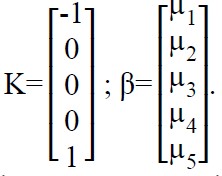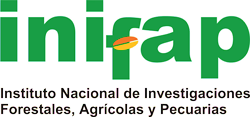Determination of the statistical power in yield experiments in corn
DOI:
https://doi.org/10.29312/remexca.v13i4.2784Keywords:
blank test, geostatistical simulations, number of repetitions, random fields, test powerAbstract
Prospective analysis of the statistical power of a hypothesis test should be one of the most important stages of any experiment; however, it is frequently omitted. In particular, for Costa Rica, no studies related to this topic were found for yield experiments in corn cultivation. The objective of this work was to determine the statistical power of a completely randomized design for yield experiments in the cultivation of corn (Zea mays) by simulating uniformity trials. To perform the calculations of power, the parameters of the spatial correlation process of a uniformity trial established in Santa Cruz, Costa Rica in 2018 were estimated. These estimates were used to perform 10 000 simulations of larger random fields, which allowed overlapping different number of repetitions and estimate the statistical power to detect a difference of 10% with respect to the mean in an experiment with a completely randomized design at a significance level of 5%. The 80% power was obtained with eight repetitions and it is concluded that, under the experimental conditions of this work, in yield trials in the cultivation of corn, to detect a difference of means of 10% at a level of significance 5%, eight or more repetitions should be used.
Downloads
References
Bivand, R. S., Pebesma, E. and Gómez-Rubio, V. 2013. Applied spatial data analysis with R. 2nd (Ed.). Springer New York. https://doi.org/10.1007/978-1-4614-7618-4. 405 p. DOI: https://doi.org/10.1007/978-1-4614-7618-4
Cerritos, G.; Gómez, F. y Palma, A. 1994. Lote demostrativo fact: introducción de una nueva metodología para evaluar híbridos de maíz en fincas de agricultores. Informe Anual de Investigación, 7(1):76-79. https://bdigital.zamorano.edu/bitstream/11036/2455/1/206105-0167 - Copy.pdf.
Cohen, J. 1988. Statistical power analysis for the behavioral sciences. 2nd (Ed.). Routledge. https://doi.org/10.4324/9780203771587. 1-17 pp. DOI: https://doi.org/10.4324/9780203771587
Cohen, J. 1992. A power primer. Psychological Bulletin. 112(1):155-159. https://doi.org/ 10.1037/0033-2909.112.1.155. DOI: https://doi.org/10.1037/0033-2909.112.1.155
Cressie, N. A. C. 1993. Statistics for spatial data. 2nd (Ed.). John wiley y sons, Inc. https://doi.org/10.1002/9781119115151. 29-105 pp. DOI: https://doi.org/10.1002/9781119115151
Diggle, P. J. and Ribeiro, P. J. 2010. Model-based geostatistics. 1st (Ed.). Springer New York. https://doi.org/10.1007/978-0-387-48536-2. 227 p. DOI: https://doi.org/10.1007/978-0-387-48536-2
Gent, D. H.; Esker, P. D. and Kriss, A. B. 2018. Statistical power in plant pathology research. Phytopathology. 108(1):15-22. https://doi.org/10.1094/PHYTO-03-17-0098-LE. DOI: https://doi.org/10.1094/PHYTO-03-17-0098-LE
González-Lutz, M. I. 2008. Potencia de prueba: la gran ausente en muchos trabajos científicos. Agron. Mesoam. 19(2):309-313. DOI: https://doi.org/10.15517/am.v19i2.5015
Guedes, L. P. C.; Bach, R. T. and Uribe-Opazo, M. A. 2020. Nugget effect influence on spatial variability of agricultural data. Engenharia Agrícola. 40(1):96-104. https://doi.org/ 10.1590/1809-4430-ENG.AGRIC.V40N1P96-104/2020.
Kuehl, R. 2001. Diseño de experimentos: principios estadísticos de diseño y análisis de investigación. 2nd (Ed.). International Thomson. 1-66 pp.
Lantuéjoul, C. 2002. Geostatistical simulation: models and algorithms. 1st (Ed.). Springer-Verlag. https://doi.org/10.1007/978-3-662-04808-5. 1-17 pp. DOI: https://doi.org/10.1007/978-3-662-04808-5
Lapeña, B. P.; Wijnberg, K. M.; Stein, A. and Hulscher, S. J. M. H. 2011. Spatial factors affecting statistical power in testing marine fauna displacement. Ecological Applications. 21(7):2756-2769. https://doi.org/10.1890/10-1887.1. DOI: https://doi.org/10.1890/10-1887.1
Montgomery, D. 2019. Design and analysis of experiments. 10nd (Ed.). John Wiley y Sons. 1- 125 pp.
Murphy, K. R., Myors, B. y Wolach, A. H. 2014. Statistical power analysis: a simple and general model for traditional and modern hypothesis tests 4th (Ed.). Routledge. 229 p.
Petitgas, P.; Woillez, M.; Rivoirard, J.; Renard, D. and Bez, N. 2017. Handbook of geostatistics in R for fisheries and marine ecology. In: ICES cooperative research report. Issue 338. https://doi.org/10.17895/ices. 98-107 pp.
Pinheiro, J.; Bates, D.; DebRoy, S. and Sarkar, D. 2016. Nlme: linear and nonlinear mixed effects models. http://cran.r-project.org/package=nlme. 338 p.
Quinn, G. P. and Keough, M. J. 2002. Experimental design and data analysis for biologists. 1st (Ed.). Cambridge University Press. https://doi.org/10.1017/CBO9780511806384. 155-172 pp. DOI: https://doi.org/10.1017/CBO9780511806384
R Core Team. 2020. R: a language and environment for statistical computing. R Foundation for Statistical Computing, Vienna, Austria. URL https://www.R-project.org/.
Ribeiro, P. J. and Diggle, P. J. 2001. Geor: a package for geostatistical analysis. R-News. 1(2):15-18. https://doi.org/10.1159/000323281. DOI: https://doi.org/10.1159/000323281
Richter, C. and Kroschewski, B. 2012. Geostatistical models in agricultural field experiments: investigations based on uniformity trials. Agron. J. 104(1):91-105. https://doi.org/10.2134/ agronj2011.0100. DOI: https://doi.org/10.2134/agronj2011.0100
Robledo, W. 2015. Diseño y análisis de experimentos a un criterio de clasificación. Estadística y biometría: ilustraciones del uso de Infostat en problemas de agronomía. 2nd (Ed.). Editorial Brujas. 257-285 pp.
Stroup, W. 2002. Power analysis based on spatial effects mixed models: a tool for comparing design and analysis strategies in the presence of spatial variability. J. Agric. Biol. Environ. Statistics. 7(4):491–511. https://doi.org/10.1198/108571102780. DOI: https://doi.org/10.1198/108571102780
Vargas-Rojas, J. C. 2021. Simulación de ensayos en blanco para determinar la potencia estadística de de experimentos en arroz. Agron. Mesoam. 32(1):196-208. https://doi.org/10.15517/ am.v32i1.40870.
Vargas-Rojas, J. C. y Navarro-Flores, J. R. 2020. Determinación del tamaño y la forma de unidad experimental, con el método de regresión múltiple, para ensayos de rendimiento de maíz (Zea mays), guanacaste, Costa Rica. InterSedes. 21(43):1-10. https://doi.org/10.15517/ isucr.v21i43.41972.
West, B. T., Welch, K. B., y Gałecki, A. T. 2015. Linear mixed models: a practical guide using statistical Software. 2nd (Ed.). CRC Press. 38-41 pp. DOI: https://doi.org/10.1201/b17198

Published
How to Cite
Issue
Section
License
Copyright (c) 2022 Revista Mexicana de Ciencias Agrícolas

This work is licensed under a Creative Commons Attribution-NonCommercial 4.0 International License.
The authors who publish in Revista Mexicana de Ciencias Agrícolas accept the following conditions:
In accordance with copyright laws, Revista Mexicana de Ciencias Agrícolas recognizes and respects the authors’ moral right and ownership of property rights which will be transferred to the journal for dissemination in open access. Invariably, all the authors have to sign a letter of transfer of property rights and of originality of the article to Instituto Nacional de Investigaciones Forestales, Agrícolas y Pecuarias (INIFAP) [National Institute of Forestry, Agricultural and Livestock Research]. The author(s) must pay a fee for the reception of articles before proceeding to editorial review.
All the texts published by Revista Mexicana de Ciencias Agrícolas —with no exception— are distributed under a Creative Commons License Attribution-NonCommercial 4.0 International (CC BY-NC 4.0), which allows third parties to use the publication as long as the work’s authorship and its first publication in this journal are mentioned.
The author(s) can enter into independent and additional contractual agreements for the nonexclusive distribution of the version of the article published in Revista Mexicana de Ciencias Agrícolas (for example include it into an institutional repository or publish it in a book) as long as it is clearly and explicitly indicated that the work was published for the first time in Revista Mexicana de Ciencias Agrícolas.
For all the above, the authors shall send the Letter-transfer of Property Rights for the first publication duly filled in and signed by the author(s). This form must be sent as a PDF file to: revista_atm@yahoo.com.mx; cienciasagricola@inifap.gob.mx; remexca2017@gmail.
This work is licensed under a Creative Commons Attribution-Noncommercial 4.0 International license.


